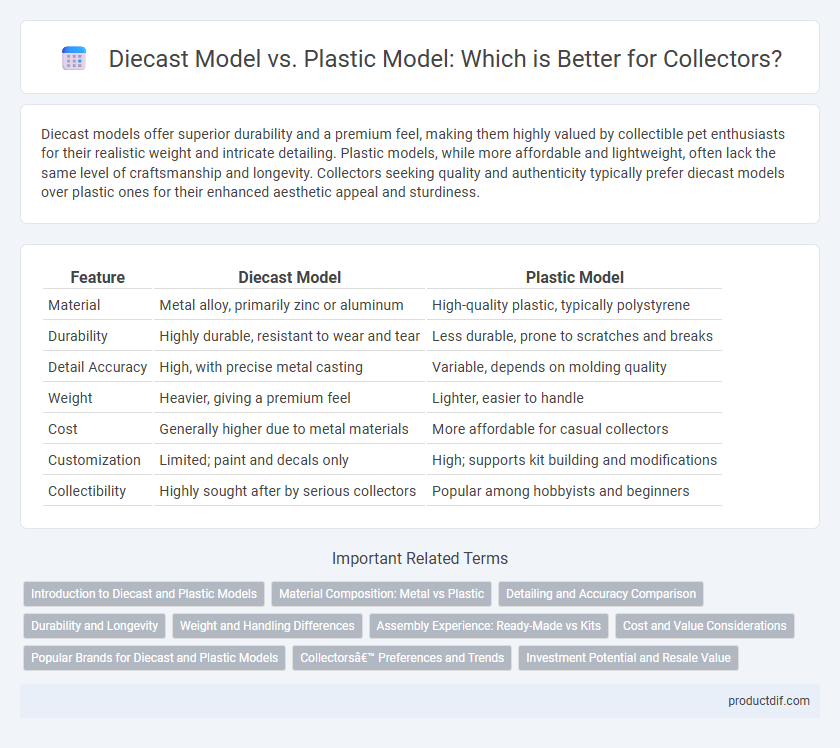Diecast models offer superior durability and a premium feel, making them highly valued by collectible pet enthusiasts for their realistic weight and intricate detailing. Plastic models, while more affordable and lightweight, often lack the same level of craftsmanship and longevity. Collectors seeking quality and authenticity typically prefer diecast models over plastic ones for their enhanced aesthetic appeal and sturdiness.
Table of Comparison
| Feature | Diecast Model | Plastic Model |
|---|---|---|
| Material | Metal alloy, primarily zinc or aluminum | High-quality plastic, typically polystyrene |
| Durability | Highly durable, resistant to wear and tear | Less durable, prone to scratches and breaks |
| Detail Accuracy | High, with precise metal casting | Variable, depends on molding quality |
| Weight | Heavier, giving a premium feel | Lighter, easier to handle |
| Cost | Generally higher due to metal materials | More affordable for casual collectors |
| Customization | Limited; paint and decals only | High; supports kit building and modifications |
| Collectibility | Highly sought after by serious collectors | Popular among hobbyists and beginners |
Introduction to Diecast and Plastic Models
Diecast models are crafted from metal alloys, offering superior durability and weight that appeal to serious collectors seeking authenticity and a premium feel. Plastic models provide lightweight, intricate detailing at a lower cost, making them popular for detailed customization and model kit assembly. Both types serve distinct collector interests, with diecast favored for display quality and plastic for versatility in modeling.
Material Composition: Metal vs Plastic
Diecast models feature a metal alloy composition, primarily zinc and aluminum, offering enhanced durability, weight, and a premium feel compared to plastic models. Plastic models utilize materials like ABS or polystyrene, allowing for finer detail and easier customization but with less weight and longevity. Collectors often prefer diecast for its robust construction and realistic heft, while plastic models appeal due to intricate detailing and affordability.
Detailing and Accuracy Comparison
Diecast models offer superior detailing and accuracy due to their metal construction, enabling finer textures and crisp molded features that closely replicate real vehicles. Plastic models often lack the weight and durability of diecast but allow for intricate customization and sharper small-scale details through advanced injection molding techniques. Collectors seeking authentic replication prioritize diecast for its robustness and precise finishes, while hobbyists favor plastic models for adaptability in detailing accuracy.
Durability and Longevity
Diecast models exhibit superior durability due to their metal construction, making them more resistant to wear, deformation, and environmental damage compared to plastic models. Plastic models tend to be more prone to warping, discoloration, and breakage over time, reducing their longevity in a collectible context. Collectors often prefer diecast models for their ability to maintain structural integrity and aesthetic appeal across decades.
Weight and Handling Differences
Diecast models are significantly heavier due to their metal construction, offering a solid and premium feel that enhances display stability and authenticity for collectors. Plastic models, by contrast, are lighter and often more fragile, making them easier to handle but less durable over time. The weight difference impacts maneuverability, with diecast models providing a sturdier grip and plastic models allowing for more detailed yet delicate designs.
Assembly Experience: Ready-Made vs Kits
Diecast models offer a ready-made, high-detail collectible experience with minimal assembly, ideal for collectors seeking immediate display quality and durability. Plastic model kits provide a hands-on assembly process that allows customization and skill development, appealing to hobbyists who enjoy building and personalizing their models. The choice between diecast and plastic reflects a preference for convenience versus creative engagement in the collectible community.
Cost and Value Considerations
Diecast models typically carry a higher price due to their metal construction and intricate detailing, offering collectors greater durability and perceived value over time. Plastic models, while more affordable and lightweight, often lack the same level of detail and longevity, which can affect their resale value. Collectors seeking long-term investment often favor diecast models for their robustness and potential appreciation in the collectibles market.
Popular Brands for Diecast and Plastic Models
Popular brands for diecast models include Hot Wheels, Matchbox, and Maisto, known for their detailed metal construction and durability, making them highly sought after by collectors. In contrast, plastic models are dominated by brands like Revell, Tamiya, and Airfix, offering intricate assembly kits favored for customization and scale accuracy. The choice between diecast and plastic models often depends on collector preference for detail, durability, and the hands-on building experience.
Collectors’ Preferences and Trends
Diecast models attract collectors who value durability, realistic weight, and fine metal detailing, making them highly sought after for display and investment purposes. Plastic models appeal to hobbyists interested in customization and intricate assembly, often favoring detailed parts and paint options. Current trends indicate a growing market for limited-edition diecast models due to their perceived value and collectibility, while plastic models maintain strong popularity in niche modeling communities seeking creative engagement.
Investment Potential and Resale Value
Diecast models hold a stronger investment potential and higher resale value compared to plastic models due to their durability, detailed craftsmanship, and limited production runs that appeal to serious collectors. The metal construction of diecast models enhances longevity and authenticity, factors that significantly influence market demand and pricing in the collectible sector. Plastic models, while often more affordable and accessible, typically depreciate faster and attract less passionate buyers, making them less viable as long-term investment assets.
Diecast Model vs Plastic Model Infographic

 productdif.com
productdif.com